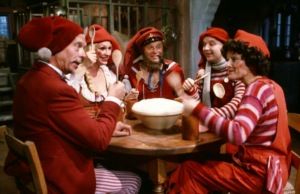Business & Education
The holiday tradition that’s best enjoyed on the sofa
This article is more than 9 years old.
The Julekalender festive television series have been a part of the Danish Christmas package for almost four decades

Nissebanden from 1984 is one of the classics (photo: DR)
Even in today’s digital era, most people still picture an advent calendar as a 2D cardboard affair, with 24 small windows filled with surprises – chocolate or visual – to open daily from December 1 until Christmas itself. An older tradition is to light an advent candle, which burns a little more each day, all the way until Christmas. In Denmark, however, the advent countdown became an audio-visual adventure as far back as the 1960s.
The theme is always Christmas, but how this topic is handled, as well as the target age group, varies considerably. There is a huge rivalry between the two major broadcasting companies in Denmark, Danmarks Radio (DR) and TV2, while even some of the smaller channels now offer their own Christmas alternative: in 2009, no less than eight advent or Julekalender series were shown throughout the month of December.
The first ever Julekalender show, ‘Historier fra Hele Verden’ (Stories from around the world), was broadcast by national broadcaster DR in 1962. The inspiration came from neighbouring country Sweden, where something similar had started two years earlier. However, it wasn’t until 1967 that the concept really began to collect the nation around the family television sets, when the irresistibly happy mouse Magnus Tagmus appeared in ‘Kender du Decembervej?’ (Do you know December Street?) with his catchy song ‘My name is Magnus Tagmus’. It proved so popular that a sequel was shown the following year: ‘Besøg på decembervej’ (Visit to December Street).
Red-nosed rivals
Like most TV programmes of the time, these first series were in black and white, and it wasn’t until 1971 that an advent series in colour hit Danish screens.
The Julekalender TV series was supplemented in 1977 by the Børnernes U-landskalender, a standard cardboard advent calendar with the same theme as that year’s series, which was sold to support projects in developing nations. It’s an initiative that has continued ever since.
In 1990, TV2 started both a rival Julekalender series for children and, for the first time, a more adult-themed 24-part series. DR1 was not slow to follow and offered a grown-up advent series in 1991. Still popular today, the advent calendars for grown-ups tend to be shown at around 10pm and are highly satirical, like the bizarre, beer-swilling characters of DR2’s 2003 series ‘Jul på Vesterbro’ (Christmas in Vesterbro).
Looking Grimm this year
Perennial favourites include TV2’s ‘Alletiders Jul’ (Great Christmas), featuring the highly popular character of Pyrus, which has managed three repeats since it was first shown in 1994. The last of these was in 2000 and coincided with the feature film ‘Pyrus i Alletiders Historie’. A modern update of the traditional nisse or Christmas imp with a wisecracking, streetwise attitude, Pyrus is hugely popular throughout Scandinavia – yet somehow hasn’t managed to break through into the foreign market, despite an English version of the series retitled as ‘The 25 Days of Christmas’.
In contrast, acclaimed series ‘Jesus & Josefine’, which was shown first in 2003 and is one of the few occasions that the Christian message of Christmas has made it into the television Julekalender, has been shown in 20 different countries.
This year, DR1’s coming-of-age drama ‘Den Anden Verden’ (the other world), which starts tonight at 19:30, is a modern retelling of the Snow White story and other Brothers Grimm classics, and it comes complete with adolescent love content and plenty of shocks.










































